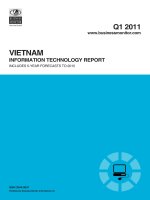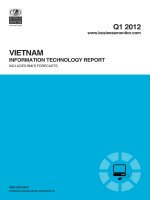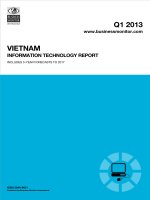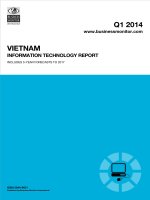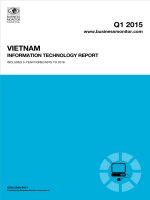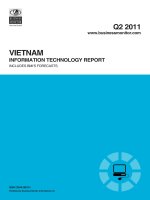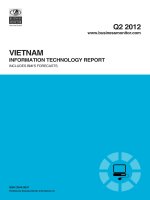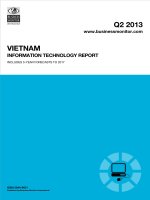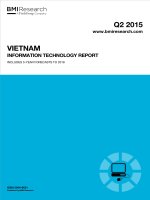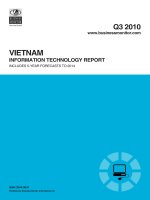Vietnam information technology report q1 2013
Bạn đang xem bản rút gọn của tài liệu. Xem và tải ngay bản đầy đủ của tài liệu tại đây (397.1 KB, 67 trang )
Q1 2013
www.businessmonitor.com
VIETNAM
INFORMATION TECHNOLOGY REPORT
INCLUDES 5-YEAR FORECASTS TO 2017
ISSN 2044-9631
Published by:Business Monitor International
Vietnam Information Technology
Report Q1 2013
INCLUDES 5-YEAR FORECASTS TO 2017
Part of BMI’s Industry Report & Forecasts Series
Published by: Business Monitor International
Copy deadline: February 2013
Business Monitor International
Senator House
85 Queen Victoria Street
London
EC4V 4AB
United Kingdom
Tel: +44 (0) 20 7248 0468
Fax: +44 (0) 20 7248 0467
Email:
Web:
© 2013 Business Monitor International
All rights reserved.
All information contained in this publication is
copyrighted in the name of Business Monitor
International, and as such no part of this
publication may be reproduced, repackaged,
redistributed, resold in whole or in any part, or used
in any form or by any means graphic, electronic or
mechanical, including photocopying, recording,
taping, or by information storage or retrieval, or by
any other means, without the express written consent
of the publisher.
DISCLAIMER
All information contained in this publication has been researched and compiled from sources believed to be accurate and reliable at the time of
publishing. However, in view of the natural scope for human and/or mechanical error, either at source or during production, Business Monitor
International accepts no liability whatsoever for any loss or damage resulting from errors, inaccuracies or omissions affecting any part of the
publication. All information is provided without warranty, and Business Monitor International makes no representation of warranty of any kind as
to the accuracy or completeness of any information hereto contained.
CONTENTS
BMI Industry View 7
SWOT 9
Political 11
Economic 12
Business Environment 13
Industry Forecast 14
Table: Vietnam IT Industry - Historical Data And Forecasts (US$mn unless otherwise stated) 17
Broadband 17
Table: Telecoms Sector - Internet - Historical Data And Forecasts 17
Economic Analysis 20
Macroeconomic Forecast 20
Ratings Downgrade Failed To Surprise Investors 21
Early Signs Of A Recovery 23
Threat Of Slower Growth Yet To Undermine Efforts For Reforms 23
Expenditure Breakdown 23
Table: Vietnam - Economic Activity 24
Industry Risk Reward Ratings 25
Industry Risk/Reward Ratings 25
Table: Asia Pacific IT Risk/Reward Ratings, Q113 28
Market Overview 29
Asia Pacific Regional Market Overview 29
IT Penetration 29
IT Growth and Drivers 31
Sectors And Verticals 33
Vietnam 37
Table: Vietnam 37
Industry Trends And Developments 45
Regulatory Development 48
Competitive Landscape 50
Company Profile 57
FPT Software 57
Demographic Forecast 59
Vietnam Demographic Forecast 59
Vietnam Information Technology Report Q1 2013
© Business Monitor International Page 4
Table: Vietnam's Population By Age Group, 1990-2020 ('000) 60
Table: Vietnam's Population By Age Group, 1990-2020 (% of total) 60
Table: Vietnam's Key Population Ratios, 1990-2020 61
Table: Vietnam's Rural And Urban Population, 1990-2020 62
Methodology 63
How We Generate Our Industry Forecasts 63
IT Industry 63
IT Ratings - Methodology 64
Table: IT Business Environment Indicators 65
Weighting 66
Table: Weighting Of Components 66
Sources 66
Vietnam Information Technology Report Q1 2013
© Business Monitor International Page 5
BMI Industry View
BMI View: Vietnamese IT spending is expected to reach US$2.9bn in 2013, up 15%, with BMI upwardly
revising its forecast due to macroeconomic factors. Drivers including rising PC penetration, economic
growth, a range of government ICT initiatives and a campaign to develop Vietnam's domestic IT industry
will help to sustain continued expansion. Vietnam's improving ICT infrastructure will also drive the
development of the nation's IT market in a country with 20% PC penetration. Meanwhile, there is strong
demand for ERP solutions and cloud computing revenues are expected to report at least 300% growth over
the five-year forecast period to 2017.
Headline Expenditure Projections
Computer Hardware Sales: US$1.8bn in 2012 to US$2.1bn in 2013, +13% in US dollar terms. Forecast in
US dollar terms unchanged; however, Windows 8 tablets and notebooks are expected to provide a growth
area in 2012.
Software Sales: US$223mn in 2012 to US$264mn in 2013, +18% in US dollar terms. Forecast in US dollar
terms upwardly revised due to analyst modification, but will depend on the success in bringing down illegal
software use.
IT Services Sales: US$477mn in 2012 to US$569mn in 2013, +19% in US dollar terms. Forecast in US
dollar terms upwardly revised due to analyst modification with growing demand for digital infrastructure
projects in various sectors, such as banking, telecoms, energy and government.
Risk/Reward Ratings: Vietnam scores 33.2 out of 100 in our Asia Risk/Reward Ratings table. This places
the country 11th, ahead of Sri Lanka. The country ranks only 11th for its industry rewards score, with 36.9.
Key Trends & Developments.
■
In 2012, vendors reported continued robust sales of ERP solutions, despite the uncertain economic
situation. There is still a lot of potential for Vietnamese enterprises to increase spending on basic
solutions. A number of Vietnamese companies embarked on large-scale ERP implementations, including
Hoang Anh Gia Lai Group (HAGL), which launched a VND100bn ERP system. However, while the
ERP market is strong, it is estimated that only about 10% of Vietnamese businesses have used CRM.
■
A number of government ministries and organisations, including the Ministry of Education and Training,
have started to promote the rollout of cloud services. Plans to modernise IT in government agencies and
the customs department, as well as the Tax Administration Modernization Plan for 2008-2013, represent
opportunities for vendors of IT products and services.
Vietnam Information Technology Report Q1 2013
© Business Monitor International Page 7
■
An ambitious government IT plan for 2010-2020 should shape many segments of the Vietnamese IT
market, with the government pledging to invest VND2.4tn (US4,115mn) from the State Budget in the
ICT sector over this period. The government's increasing focus on encouraging ICT development and
foreign investment in the technology sector will also create opportunities. Many of the government's ICT
development plans and programmes are still in a nascent stage and their ultimate effectiveness is yet to be
determined.
Vietnam Information Technology Report Q1 2013
© Business Monitor International Page 8
SWOT
SWOT Analysis
Strengths
■
Vietnam's gradual integration into the global trade network via its accession into trade
organisations such as ASEAN and WTO, as well as bilateral agreements with Japan
and China.
■
The domestic IT market is in a rapid growth phase, with trade liberalisation and
growing affordability driving projected double-digit growth of notebook computers.
■
Expanding ICT infrastructure and internet penetration will continue to drive demand
for IT products and services.
Weaknesses
■
IT spend per capita much lower than in neighbouring Thailand, reflecting a much
lower GDP and GDP per capita.
■
Low levels of access to credit and budgets restrain spending by SMEs.
■
Highly cost-sensitive market, with 75% of software provided by lower-cost local
software vendors.
■
High level of software piracy at 85%, although it has fallen in the last few years.
Opportunities
■
High PC market growth potential particular in rural areas due to overall low PC
penetration rate of 15%.
■
Vast and relatively under-penetrated rural market presents a significant growth
opportunity as the government rolls out measures to boost rural connectivity and
incomes.
■
National IT Plan will drive spending on IT utilisation in areas such as e-government, e-
taxation and education.
■
SMEs have much potential to increase spending on basic solutions, including
customer relationship management and security.
■
The banking and finance sector is a promising area for database software and one
where foreign companies have done well.
Vietnam Information Technology Report Q1 2013
© Business Monitor International Page 9
SWOT Analysis - Continued
■
Banking and finance, oil and gas, aviation and telecoms are projected to be some of
the biggest opportunities for multinational vendors.
■
Tax agencies at all levels of administration are looking to increase the efficiency of tax
collection.
■
The government's drive to create a significant IT services industry over the next 15-20
years is expected to be a significant factor shaping the IT market.
Threats
■
Continued depreciation of the dong against the US dollar would increase the pressure
on Vietnamese distributors of foreign IT goods.
■
Falling prices may further undermine margins and profitability after steep discounting
in 2009.
■
The implementation of the China-ASEAN free trade agreement means that
established multinationals will face a growing challenge from low-cost Chinese
vendors in the Vietnamese market.
Vietnam Information Technology Report Q1 2013
© Business Monitor International Page 10
Political
SWOT Analysis
Strengths
■
The Communist Party of Vietnam remains committed to market-oriented reforms and
we do not expect major shifts in policy direction over the next five years. The one-
party system is generally conducive to short-term political stability.
■
Relations with the US have witnessed a marked improvement, and Washington sees
Hanoi as a potential geopolitical ally in South East Asia.
Weaknesses
■
Corruption among government officials poses a major threat to the legitimacy of the
ruling Communist Party.
■
There is increasing (albeit still limited) public dissatisfaction with the leadership's tight
control over political dissent.
Opportunities
■
The government recognises the threat corruption poses to its legitimacy, and has
acted to clamp down on graft among party officials.
■
Vietnam has allowed legislators to become more vocal in criticising government
policies. This is opening up opportunities for more checks and balances within the
one-party system.
Threats
■
Macroeconomic instabilities in 2012 are likely to weigh on public acceptance of the
one-party system, and street demonstrations to protest economic conditions could
develop into a full-on challenge of undemocractic rule.
■
Although strong domestic control will ensure little change to Vietnam's political scene
in the next few years, over the longer term, the one-party-state will probably be
unsustainable.
■
Relations with China have deteriorated over recent years due to Beijing's more
assertive stance over disputed islands in the South China Sea and domestic criticism
of a large Chinese investment into a bauxite mining project in the central highlands,
which could potentially cause wide-scale environmental damage.
Vietnam Information Technology Report Q1 2013
© Business Monitor International Page 11
Economic
SWOT Analysis
Strengths
■
Vietnam has been one of the fastest-growing economies in Asia in recent years, with
GDP growth averaging 7.1% annually between 2000 and 2011.
■
The economic boom has lifted many Vietnamese out of poverty, with the official
poverty rate in the country falling from 58% in 1993 to 14.0% in 2010.
Weaknesses
■
Vietnam still suffers from substantial trade, current account and fiscal deficits, leaving
the economy vulnerable to global economic uncertainties in 2012. The fiscal deficit is
dominated by substantial spending on social subsidies that could be difficult to
withdraw.
■
The heavily-managed and weak currency reduces incentives to improve quality of
exports, and also keeps import costs high, contributing to inflationary pressures.
Opportunities
■
WTO membership has given Vietnam access to both foreign markets and capital,
while making Vietnamese enterprises stronger through increased competition.
■
The government will in spite of the current macroeconomic woes, continue to move
forward with market reforms, including privatisation of state-owned enterprises, and
liberalising the banking sector.
■
Urbanisation will continue to be a long-term growth driver. The UN forecasts the
urban population rising from 29% of the population to more than 50% by the early
2040s.
Threats
■
Inflation and deficit concerns have caused some investors to re-assess their hitherto
upbeat view of Vietnam. If the government focuses too much on stimulating growth
and fails to root out inflationary pressure, it risks prolonging macroeconomic
instability, which could lead to a potential crisis.
■
Prolonged macroeconomic instability could prompt the authorities to put reforms on
hold as they struggle to stabilise the economy.
Vietnam Information Technology Report Q1 2013
© Business Monitor International Page 12
Business Environment
SWOT
Strengths
■
Vietnam has a large, skilled and low-cost workforce, which has made the country
attractive to foreign investors.
■
Vietnam's location - its proximity to China and South East Asia, and its good sea links
- makes it a good base for foreign companies to export to the rest of Asia and
beyond.
Weaknesses
■
Vietnam's infrastructure is still weak. Roads, railways and ports are inadequate to
cope with the country's economic growth and links with the outside world.
■
Vietnam remains one of the world's most corrupt countries. According to
Transparency International's 2012 Corruption Perceptions Index, Vietnam ranks 123rd
out of 176 countries.
Opportunities
■
Vietnam is increasingly attracting investment from key Asian economies, such as
Japan, South Korea and Taiwan. This offers the possibility of the transfer of high-tech
skills and know-how.
■
Vietnam is pressing ahead with the privatisation of state-owned enterprises and the
liberalisation of the banking sector. This is likely to offer foreign investors new entry
points.
Threats
■
Ongoing trade disputes with the US, and the general threat of American
protectionism, which will remain a concern.
■
Labour unrest remains a lingering threat. A failure by the authorities to boost skills
levels could leave Vietnam a second-rate economy for an indefinite period.
Vietnam Information Technology Report Q1 2013
© Business Monitor International Page 13
Industry Forecast
The Vietnamese IT market is estimated to grow at a compound annual growth rate (CAGR) of 15% over the
2013-2017 forecast period. The addressable domestic market for IT products and services is projected by
BMI to reach US$2.9bn in 2013 and US$5.0bn by 2017.
The PC market should receive a boost in 2013 from the release of a new generation of Windows 8
notebooks and tablets. Sales decelerated in Q112, with low single-digit growth compared with the same
period in the previous year, but picked up later in the year. Government and business IT spending remains
subject to fiscal restraints and external economic headwinds, and the devaluation of the dong will also
inhibit demand. Despite the uncertain economic outlook, vendors have reported robust enterprise demand
for enterprise resource planning (ERP) solutions. Factors such as growing PC penetration, economic
growth, a range of government ICT initiatives and ambitious plans to grow Vietnam's IT industry will help
to underpin strong growth.
2013 Outlook
The overall Vietnamese IT market outlook for 2013 is one of solid advance, but one which is vulnerable to
a slowdown in China, the US and Europe. The Vietnam IT market is expected to grow around 15% in 2013,
slightly below the level estimated in 20112, but still comfortably among the fastest growth rates in the
region. The Vietnamese economy is expected to remain strong and drive growth in IT investments. The
government's increasing focus on encouraging foreign investment in the technology sector will also create
opportunities.
Retail PC sales should overall remain strong in 2013 as new vendors enter the market and others release
new models, particularly of Windows 8 devices. However, many businesses and individuals remain price-
sensitive, with much demand being for lower-priced second computers. Tablets reported strong growth in
2012 and, with falling prices, are expected to maintain this performance in 2013, while ultrabooks will
provide a new growth area.
Government spending and PC subsidy programmes will support the PC market as the government continues
to roll out IT modernisation programmes. In 2011 the government spent VND856bn on ICT in the first 11
months of the year, with around 50% of this going to hardware. Government support should also drive
Vietnam's emergence as an alternative and cheaper outsourcing destination to India and China. Cloud
computing is another growth area.
Vietnam Information Technology Report Q1 2013
© Business Monitor International Page 14
Drivers
The Vietnamese IT market is expected to have a number of long-term drivers. The government's ambitious
plan for Vietnam's IT society and IT market covers the 2010-2020 period and should shape many segments
of the IT market. Plans to modernise IT in government agencies and the customs department, as well as the
Tax Administration Modernisation Plan for 2008-2013, represent opportunities for vendors of IT products
and services. A number of government ministries and organisations, including the Ministry of Education
and Training, have started to promote the rollout of cloud services.
Vietnam's improving ICT infrastructure will also drive the development of the nation's IT market. In a
country with below 20% PC penetration, government digital divide programmes to boost internet and digital
utility in rural areas underpin addressable market growth and open PC ownership to a growing number of
rural inhabitants. The government's 2008-2013 programme for developing the internet in rural communities
is one example, as are various policies to boost rural incomes.
Meanwhile, broadband service providers will continue to expand penetration in rural and remote areas. The
spread of fixed and mobile broadband services will spur purchases of mobile PCs as connectivity devices.
As elsewhere, telecoms operators such as Viettel are emerging as significant distribution channels for
notebooks as vendors seek tie-ups.
Vietnam's gradual integration into global trade networks, such as ASEAN and the WTO, has helped to bring
down tariff barriers and prices, as well as increase opportunities for importers. In January 2009, duty on
CBU electronic products from ASEAN countries was reduced to 0-5%. Meanwhile, the Vietnam-Japan
economic partnership agreement, which also came into effect at the start of 2009, lowered import taxes on
electronics goods from Japan by 2.5-4.5%.
Tariff reductions, particularly the ASEAN ones, have contributed to lower prices and a boost to PC sales.
However, the new China-ASEAN free trade agreement offers both opportunities and challenges to vendors,
given the growing presence of low-cost Chinese vendors in the Vietnamese market.
Meanwhile, the government's drive to create a significant IT services industry over the next 15-20 years is
expected to be a significant factor shaping the IT services market as Vietnam leverages its competitive
prices to claim a larger share of the global outsourcing market. Future growth will, however, depend on
government progress on various business environment issues, including copyright protection. Further
progress in combating software piracy, which still accounts for around 83% of installed software compared
with 76% in neighbour Thailand, would support the growth of the software market. Although high, the
Vietnam Information Technology Report Q1 2013
© Business Monitor International Page 15
piracy rate has fallen from around 95% in the last few years as the government has implemented stricter
regulations.
Segments
Government remains a key IT spending segment and accounts for around 30% of total Vietnamese IT
spending. In 2010 the prime minister ordered all cabinet ministers to use computers as part of a two-year
plan to increase IT use in government. Such initiatives are driving IT spending by agencies at central,
municipal and provincial government levels.
The private sector comprises around 60% of IT spending. Larger Vietnamese companies remain more likely
to buy higher-priced software from multinationals, which have only around 25% of the local software
market. In the large corporate sector, growing demand for digital infrastructure projects in segments such as
banking, telecoms and energy has attracted global IT services leaders, such as IBM, to invest in Vietnam.
Foreign investment, particularly by Japanese companies, in call centres and other areas will help to grow the
market.
Smaller enterprises will be a vendor focus due to their growing awareness of the benefits of IT utilisation,
but this segment is constrained by low budgets and lack of access to credit. Companies are looking for
software that will help boost performance and operational efficiency. Promising SME verticals include
discrete manufacturing and consumer packaged goods, as well as hotels and property management. The
solution areas with most demand currently include security software and key applications such as CRM,
ERP and HR management.
The banking and finance sector is a promising area for database software and one where foreign companies
have done well. Spending opportunities in the finance segment will be driven by regulatory compliance, due
to regulations such as Basel II, HIPPA and the Sarbanes-Oxley Act, and quite likely by new regulations
introduced in the wake of the global financial crisis.
An increasing number of Vietnamese companies have shown an interest in and willingness to use cloud
services. The government has also got involved in encouraging the development of this business model in
Vietnam and new cloud computing offerings and increased competition in this segment should fuel further
demand from end-users to utilise this technology.
Vietnam Information Technology Report Q1 2013
© Business Monitor International Page 16
Summary
Overall, the hardware market is anticipated to grow from US$2.1bn in 2013 to US$3.5bn in 2017, with
computer sales rising from US$1.7bn to US$2.9bn over the same period. Software spending should rise
from US$264mn to US$498mn and IT services from US$569mn to US$1.1bn over the forecast period.
Table: Vietnam IT Industry - Historical Data And Forecasts (US$mn unless otherwise stated)
2010 2011 2012f 2013f 2014f 2015f 2016f 2017f
IT market 1,928 2,198 2,547 2,925 3,400 3,897 4,426 5,039
IT market as % GDP 1.9 1.8 1.8 1.8 1.9 1.9 1.9 1.9
Hardware (computer
market sales)
1,427 1,616 1,847 2,091 2,397 2,708 3,032 3,451
Services 342 395 477 569 687 815 957 1,090
Software 159 187 223 264 316 374 437 498
PCs (including
notebooks)
1,156 1,312 1,514 1,732 1,985 2,242 2,510 2,858
Servers 128 145 166 188 216 244 273 311
f = BMI forecast. Source: BMI, EITO, World Bank, ITU, EU, IDC, Gartner, Romania Ministry of Communications & IT, ISI
Broadband
Table: Telecoms Sector - Internet - Historical Data And Forecasts
2010 2011 2012e 2013f 2014f 2015f 2016f 2017f
No. of internet users ('000) 26,905 31,159 31,782 32,418 33,066 33,727 34,402 35,090
No. of internet users/100 inhabitants 30.6 35.1 35.4 35.8 36.1 36.5 36.9 37.3
No. of fixed broadband internet subscribers ('000) 3,644 4,085 4,452 4,719 4,955 5,154 5,308 5,467
No. of fixed broadband internet subscribers/100
inhabitants 4.1 4.6 5.0 5.2 5.4 5.6 5.7 5.8
e/f = BMI estimate/forecast. Source: BMI, VNNIC
Vietnam Information Technology Report Q1 2013
© Business Monitor International Page 17
According to data provided by the Vietnam Internet
Network Information Centre (VNNIC), there were
31.2mn internet users in Vietnam at the end of
September 2012.
Vietnam's internet sector continued to exhibit slower
growth in 2012, continuing on from the trend seen in
2011. The average monthly growth rate for 2011 was
1.1%, which was lower than the growth average in
2010 (1.4%). The first nine months of 2012 saw
even weaker growth with an average m-o-m growth
rate of just 0.2%. Given that the number of 3G
subscriptions has surged in the past year, it is
possible that the VNNIC does not take into account
mobile internet users in its definition. We retain our
previous forecasts, which were downgraded in the
previous quarter due to the lower-than-expected
growth trajectory. Fixed internet services are experiencing muted growth due to the higher cost of
ownership as consumers need to purchase personal computers, namely desktops and notebooks. We expect
32.4mn internet subscribers in Vietnam at the end of 2013, a penetration rate of 35.8%. We expect this
number to increase to 35.1mn by end-2017, a 37.3% penetration rate.
Nevertheless, we believe that Vietnam's internet sector offers strong long-term growth potential. On one
hand, internet user growth to date has been largely confined to urban centres, but the internet user
penetration rate is expected to be approaching saturation in major cities and towns. Rural Vietnam remains
comparatively untapped as a result of consumers' lower purchasing power. This means that the ability to
achieve higher growth rates in the future will depend on the pace of internet infrastructure development in
rural parts of the country and the prices of consumer electronics and internet services.
Vietnam's fixed broadband subscriber market grew by 22.8% in 2010, which was a significant slowdown
from 44.8% in the preceding year. The market registered growth rates of 150.3% in 2007 and 58.3% in
2008, but the higher growth momentum could be attributed to a low-base effect. Vietnam's broadband
industry hit a rocky patch in the first 10 months of 2011. The market contracted in three of the months, most
Industry Trends - Internet Sector
2010-2017
e/f = BMI estimate/forecast. Source: BMI, VNNIC
Vietnam Information Technology Report Q1 2013
© Business Monitor International Page 18
notably 5.2% month-on-month in June 2011, but rebounded sharply in August 2011 by growing by 8.1% m-
o-m. By end-2011, there were 4.085mn fixed broadband subscribers, a 12.1% increase y-o-y.
Like the overall internet sector, Vietnam's broadband industry is experiencing a slowdown. There were
4.317mn broadband subscribers at the end of September 2012, up by 12.0% y-o-y. The average monthly
growth rate in the first nine months of 2012 was 0.6%, down from the 1.0% in the whole of 2011. This was
due to the contractions in the months ended June 2012 and September 2012.
Although Vietnamese telecoms companies continue to deploy broadband services such as fibre-to-the-x,
affordability and coverage remain key concerns in the emerging market. Furthermore, demand for
traditional fixed broadband services is increasingly under threat from mobile alternatives due to a lower cost
structure. While we believe there will be limited growth potential for the fixed broadband industry in
Vietnam in the near future, we retain an optimistic view in light of Vietnam's growing affluence and
expanding middle class. While next-generation mobile technologies LTE and WiMAX could cannibalise
demand for fixed broadband solutions, companies could generate consumer interest by introducing
bandwidth-intensive services such as IPTV or target businesses by offering bundled packages such as cloud
solutions.
We expect the growth rate of the Vietnamese broadband market to decline in the next few years as
consumers opt for mobile alternatives. That said, declining prices of products and services should help the
sector to grow by an average of 4.2% between 2013 to 2017 to bring the total number of fixed broadband
subscribers in Vietnam to 5.5mn from 4.7mn.
Vietnam Information Technology Report Q1 2013
© Business Monitor International Page 19
Economic Analysis
Macroeconomic Forecast
BMI View: Vietnam's economy remains on track for a robust recovery in 2013, and we view consensus
estimates on growth as being overly pessimistic. The latest credit downgrade by rating agency Moody's
Investors Service has failed to surprise the bond markets and we believe that this is because concerns over
the build up of bad debt in the banking sector have long been priced by investors. Furthermore, latest
economic indicators also support our view that economic conditions in Vietnam are improving and we are
maintaining our view that real GDP growth will come in strong at 7.0% in 2013.
Latest data published by the General Statistics Office (GSO) showed that Vietnam's real GDP growth
accelerated from 4.7% year-on-year (y-o-y) in Q212 to 5.4% in Q312, reinforcing our view that the
economy is poised for a robust recovery as we head into 2013. It is worthwhile to note, however, that the
general consensus remain deeply cautious towards the country's economic outlook. According to the latest
Bloomberg survey consisting of 11 economists, the median forecast for Vietnam's real GDP growth for
2013 currently stands at 5.8% while the mean forecast averaged slightly higher at 6.2%. This, in comparison
to our forecast for the Vietnamese economy to grow by a heady 7.0% in 2013, highlights the degree of
pessimism that the consensus presently holds - and what we view as an extreme in bearish macro sentiment.
Vietnam Information Technology Report Q1 2013
© Business Monitor International Page 20
Rebound In Sight
Vietnam - Real GDP, VNDbn (LHS) & % chg y-o-y (RHS)
Source: BMI, General Statistics Office
Ratings Downgrade Failed To Surprise Investors
Interestingly, Vietnam's foreign and local currency debt ratings were downgraded on September 28 by
ratings agency Moody's Investors Service from B1 to B2, citing lower growth prospects and risks to the
state balance sheet from weakness in the banking system. The latest downgrade places Vietnam's credit
rating five notches below investment grade, on par with countries such as Egypt and Cambodia. We see the
downgrade as coming somewhat behind the curve. We have been warning of a surge in bankruptcies since
the beginning of the year and the government has responded speedily by tightening supervision over the
banking sector and introducing reforms to merge ailing banks. Furthermore, we believe that the worst case
scenario of a banking crisis has already been contained.
Vietnam Information Technology Report Q1 2013
© Business Monitor International Page 21
Muted Response To Credit Downgrade
Vietnam - Two-Year & 10-Year Government Bond Yields, % & Spread, bps
Source: BMI, Bloomberg
Indeed, judging from the muted response in the bond markets following the ratings downgrade, it appears
that the risks of a potential bailout of ailing banks by the Vietnamese government have long been priced in
by investors. As the accompanying chart shows, 10-year Vietnamese sovereign bond yields have remained
largely stable within a narrow trading range of 10.25-10.50% in recent months. Yields on two-year
sovereign bonds have begun to tick up in recent weeks, following a higher-than-expected reading on
Vietnam Information Technology Report Q1 2013
© Business Monitor International Page 22
inflation in September (headline consumer price inflation accelerated from 5.0% y-o-y in August to 6.5% in
September, after recording 13 consecutive monthly declines since August 2011). However, looking at the
broader trend for bond yields (where yields have fallen substantially from the peak of around 12.5-13.0% to
current levels of around 10.0%), we believe that the recent uptick in yields do not warrant cause for alarm.
Early Signs Of A Recovery
Looking at more recent economic data, we point out that industrial production expanded by 9.7% y-o-y in
September, a significant increase from 4.4% in August and the fastest rate of expansion since February.
Retail sales for the first nine months of the year also grew by a robust 17% y-o-y, suggesting to us that
domestic demand is also starting to pick up. These factors reinforce our view that economic conditions in
Vietnam are improving and the economy is on track for a swift recovery over the coming quarters.
Accordingly, we are maintaining our view that real GDP growth will come in strong at 7.0% in 2013, and
we believe that signs of an improving economic outlook over the coming months will soon reignite bullish
sentiment towards Vietnam's growth prospects.
Threat Of Slower Growth Yet To Undermine Efforts For Reforms
Rapid credit growth and reckless lending practices among local banks have resulted in a build up of bad
debt over the years, fuelling concerns among investors that reigniting economic growth will prove to be a
challenging task in 2013. The economic slowdown in 2011 led by aggressive monetary tightening by the
SBV, resulted in a surge in NPLs and prompted banks to aggressively cut down on lending to small-and-
medium sized enterprises (SMEs). Growing evidence that real GDP growth could miss the government's
target of 6.0-6.5% in 2012 has so far failed to derail the SBV's efforts to push ahead reforms - an
encouraging sign that the government is willing to tolerate slower growth in return for macroeconomic
stability.
Over the longer term, we expect this restructuring of the banking sector alongside efforts to speed up the
privatisation of state-owned enterprises (SOE), to boost the quality of economic growth in Vietnam.
Although these reforms are unlikely to witness a smooth process, we should nonetheless see a more
efficient banking system that would allow real GDP growth to average at a robust 7.1% over the next
decade. A more efficient credit system should also see consumer price inflation averaging a benign 5.3%
over the same period.
Expenditure Breakdown
Private Consumption: We expect private consumption to grow at a relatively subdued pace of 4.9% in
2012 before accelerating towards 5.6% in 2013. However, we note that the risk of a sustained collapse in
Vietnam Information Technology Report Q1 2013
© Business Monitor International Page 23
exports and further bankruptcies among SMEs, could potentially lead to widespread job losses in export-
driven sectors. Uncertainties over the outlook for employment could in turn, prompt households to cut back
on spending.
Gross Fixed Capital Formation: We foresee a significant pickup in private sector investment growth in
2013. We believe with lending rates will gradually ease over the coming months as the effect of recent rate
cuts by the SBV begins to kick in. Accordingly, we expect gross fixed capital formation growth to
accelerate from 4.3% in 2012 to 5.6% in 2013.
Public Spending: We expect total public spending to remain relatively resilient in 2013, expanding at a
respectable pace of 5.4%. However, there is limited room for the government to increase spending further
due to concerns over the need to finance a potential bailout of ailing state-owned commercial banks.
Net Exports: Net exports remain the biggest downside risk to our outlook for the Vietnamese economy
given that we expect external demand to remain sluggish as we head into H113. Despite recording an
average monthly trade surplus of US$172mn since June 2012 (resulting in a year-to-date surplus of US
$77mn), we do not see the case for a substantial pickup in external demand in the near term. Accordingly,
we expect exports to expand at a moderate pace of 6.5% in 2013.
Table: Vietnam - Economic Activity
2010 2011 2012e 2013f 2014f 2015f 2016f
Nominal GDP,
VNDbn 2 1,980,914.00 2,535,008.00 2,913,940.20 3,314,445.00 3,776,223.10 4,265,863.00 4,807,544.50
Nominal GDP, US
$bn 2 103.5 122.7 138.5 159.3 183.6 209.8 239.2
Real GDP growth, %
change y-o-y 2 6.8 5.9 5.3 7 7.2 7.3 7.3
GDP per capita, US$
2 1,178 1,382 1,544 1,758 2,005 2,270 2,564
Population, mn 3 87.8 88.8e 89.7 90.7 91.6 92.4 93.3
Industrial production
index, % y-o-y, ave
1,4 14.1 10.9 8 12 14 13 12
Unemployment, % of
labour force, eop 4 4.3 4.5 5 4.8 4.7 4.6 4.5
Notes:
e
BMI estimates.
f
BMI forecasts.
1
at 1994 prices. Sources:
2
Asian Development Bank, General Statistics Office;
3
World Bank/UN/BMI;
4
General Statistics Office.
Vietnam Information Technology Report Q1 2013
© Business Monitor International Page 24
Industry Risk Reward Ratings
Industry Risk/Reward Ratings
BMI's Asia Pacific IT Risk/Reward Ratings (RRR) compares the potential of a selection of the region's
markets over our forecast period through to 2017. Our Q113 ratings reflect our consideration of the political
and economic risks, as well as the risks associated specifically with IT intellectual property (IP) rights
protection and the implementation of state spending projects.
While there are some changes to the countries' IT ratings, their respective rankings in our table were
unaffected. Singapore continued to head up the region with an IT rating score of 74.1, unchanged from the
previous quarter. Although Singapore's IT market is significantly smaller than many of its regional peers,
the country has other redeeming factors. The government has been aggressively encouraging the integration
of ICT services in key economic sectors and fosters a well-connected society. The InfoComm Development
Authority of Singapore has also laid out a 10-year masterplan to coordinate developments within the public
and private sector. Providing the foundation for growth is a strong and robust fixed and mobile network
infrastructure, which has deployed next generation technologies in order to spur the adoption of more
sophisticated IT solutions.
Hong Kong moved up one position to second place after its IT rating score improved to 73.4 from 72.6 the
previous quarter. The positive change was spurred by an upgrade in Hong Kong's industry rewards score
from 53.3 to 55.0. The territory has a well-established financial hub, and IT solutions present an opportunity
for companies to reduce operating costs and improve operational efficiency when carrying out transactions,
particularly cross-border trade. In addition to affordable fibre broadband services, Hong Kong's relationship
with China provides companies access to a high-growth market.
Australia fell to third position even though there were no changes to its IT rating score of 73.3. A significant
portion of the Australian IT market outlook depends on the successful implementation of the National
Broadband Network, which would provide high-speed broadband connectivity to businesses and consumers.
The project involves the use of fibre-to-the-home technology. While costly, it is reasonably future-proof.
However, the opposition Coalition party, which could assume power in the next federal election, is looking
to undo the progress made and deploy a fibre-to-the-cabinet network, which would rely on old copper
networks for the last mile.
South Korea's IT rating score improved to 64.6 as its country rewards score increased to 75.0 from 70.0 the
previous quarter, which was partially offset by a slight downgrade in its industry rewards score. The South
Vietnam Information Technology Report Q1 2013
© Business Monitor International Page 25
